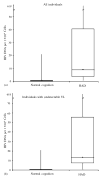Circulating proviral HIV DNA and HIV-associated dementia
- PMID: 15627032
- PMCID: PMC1557628
- DOI: 10.1097/00002030-200501030-00005
Circulating proviral HIV DNA and HIV-associated dementia
Abstract
Objective: Individuals continue to develop HIV-1-associated dementia (HAD) despite treatment with highly active antiretroviral therapy (HAART). Monocytes/macrophages (M/MPhi) can harbor proviral DNA that is not eradicated by HAART. To determine if HAD is associated with the level of HIV-1 infection within circulating leukocytes, we quantified HIV-1 DNA copy number in peripheral blood mononuclear cells (PBMC), and in PBMC subsets.
Design: Cross-sectional analysis within the Hawaii Aging with HIV Cohort comparing participants with HAD to those with normal cognition (NC).
Methods: Real-time PCR assays assessing HIV DNA copy number/1 x 10 cells were performed on PBMC and subsets.
Results: Individuals with HAD (n = 27) had a median (interquartile range) of 9.11 (37.20) HIV DNA per 1 x 10 PBMC compared to 0.49 (0.89) HIV DNA per 1 x 10 PBMC in individuals with NC (n = 22). Using a univariate analysis in the subset of individuals with undetectable viral load (HAD, n = 11; NC, n = 13), the odds of HAD attributable to HIV DNA copy number was 2.76 (1.28-5.94), P < 0.01. Preliminary analysis of a small subset of patients (n = 5) suggested that the primary source of HIV DNA may be the activated M/MPhi (CD14/CD16) subset.
Conclusions: These findings suggest a potentially important association between circulating provirus and HAD.
Figures



References
-
- Gartner S. HIV infection and dementia. Science. 2000;287:602–604. - PubMed
-
- Major Eo, Rausch D, Marra C, Clifford D. HIV-associated dementia. Science. 2000;288:440–442. - PubMed
-
- Ryan LA, Cotter RL, Zink WE, 2nd, Gendelman HE, Zheng J. Macrophages, chemokines and neuronal injury in HIV-1-associated dementia. Cell Mol Biol (Noisy-le-Grand) 2002;48 :137–150. - PubMed
-
- Sacktor N, McDermott MP, Marder K, Schifitto G, Selnes OA, McArthur JC, et al. HIV-associated cognitive impairment before and after the advent of combination therapy. J Neurovirol. 2002;8:136–142. - PubMed
-
- McArthur JC, Haughey N, Gartner S, Conant K, Pardo C, Nath A, et al. Human immunodeficiency virus-associated dementia: an evolving disease. J Neurovirol. 2003;9:205–221. - PubMed
Publication types
MeSH terms
Substances
Grants and funding
LinkOut - more resources
Full Text Sources
Research Materials

